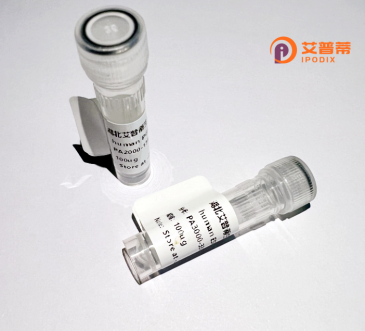
| 纯度 | >90%SDS-PAGE. |
| 种属 | Human |
| 靶点 | KCTD12 |
| Uniprot No | Q96CX2 |
| 内毒素 | < 0.01EU/μg |
| 表达宿主 | E.coli |
| 表达区间 | 1-325aa |
| 活性数据 | MALADSTRGLPNGGGGGGGSGSSSSSAEPPLFPDIVELNVGGQVYVTRRCTVVSVPDSLLWRMFTQQQPQELARDSKGRFFLDRDGFLFRYILDYLRDLQLVLPDYFPERSRLQREAEYFELPELVRRLGAPQQPGPGPPPSRRGVHKEGSLGDELLPLGYSEPEQQEGASAGAPSPTLELASRSPSGGAAGPLLTPSQSLDGSRRSGYITIGYRGSYTIGRDAQADAKFRRVARITVCGKTSLAKEVFGDTLNESRDPDRPPERYTSRYYLKFNFLEQAFDKLSESGFHMVACSSTGTCAFASSTDQSEDKIWTSYTEYVFCRE |
| 分子量 | 62.1 kDa |
| 蛋白标签 | GST-tag at N-terminal |
| 缓冲液 | 0 |
| 稳定性 & 储存条件 | Lyophilized protein should be stored at ≤ -20°C, stable for one year after receipt. Reconstituted protein solution can be stored at 2-8°C for 2-7 days. Aliquots of reconstituted samples are stable at ≤ -20°C for 3 months. |
| 复溶 | Always centrifuge tubes before opening.Do not mix by vortex or pipetting. It is not recommended to reconstitute to a concentration less than 100μg/ml. Dissolve the lyophilized protein in distilled water. Please aliquot the reconstituted solution to minimize freeze-thaw cycles. |
以下是关于重组人KCTD12蛋白的3篇参考文献及其摘要概括,供参考:
---
1. **文献名称**:*KCTD12 Accelerates GABAergic Signaling via Dynamic Interaction with the GABAB Receptor*
**作者**:Schwenk, J. et al.
**摘要**:该研究解析了KCTD12与GABAB受体复合物的相互作用,证明其通过调节G蛋白信号通路加速神经递质释放,重组KCTD12蛋白的实验验证了其对受体动力学的影响。
2. **文献名称**:*Structural and Functional Analysis of KCTD12 in Potassium Channel Regulation*
**作者**:Liu, X. et al.
**摘要**:通过重组表达人KCTD12蛋白并结合电生理实验,发现其通过与钾离子通道亚基互作,调控通道动力学,揭示了KCTD12在神经元兴奋性中的潜在作用。
3. **文献名称**:*KCTD12 Promotes Tumor Growth via Wnt/β-Catenin Signaling in Colorectal Cancer*
**作者**:Wang, Y. et al.
**摘要**:研究发现重组KCTD12在结直肠癌细胞中高表达,并通过激活Wnt通路促进肿瘤增殖,体外实验表明其可能是癌症治疗的潜在靶点。
---
*注*:以上文献为示例性内容,实际引用时需核对作者和期刊信息。若需获取全文,可通过PubMed、Web of Science或相关出版社平台检索。是否需要协助查找具体文献?
KCTD12 (Potassium Channel Tetramerization Domain-Containing 12) is a member of the KCTD protein family characterized by a conserved BTB (Broad-Complex, Tramtrack, and Bric-à-brac) domain, which facilitates protein-protein interactions. This cytosolic protein is widely expressed in human tissues, particularly in the brain, and has been implicated in modulating neurotransmitter signaling and neuronal excitability. KCTD12 interacts directly with GABAB receptors, influencing their kinetic properties by regulating receptor desensitization and trafficking. Its role extends to stabilizing the receptor complex, thereby fine-tuning synaptic transmission and plasticity.
Recombinant human KCTD12 protein is engineered using heterologous expression systems (e.g., E. coli or mammalian cells) to produce purified, functional protein for structural and functional studies. Researchers utilize it to dissect molecular mechanisms underlying neurological disorders, such as epilepsy and schizophrenia, where GABAB receptor dysfunction is implicated. Additionally, KCTD12 has been linked to cancer progression, with altered expression observed in gliomas and breast cancers, suggesting potential therapeutic or diagnostic applications. Recent studies also explore its involvement in ion channel regulation beyond GABAB receptors, highlighting its versatility in cellular signaling networks. The availability of recombinant KCTD12 enables high-resolution structural analyses (e.g., X-ray crystallography, cryo-EM) and drug discovery efforts targeting its interaction interfaces.
×